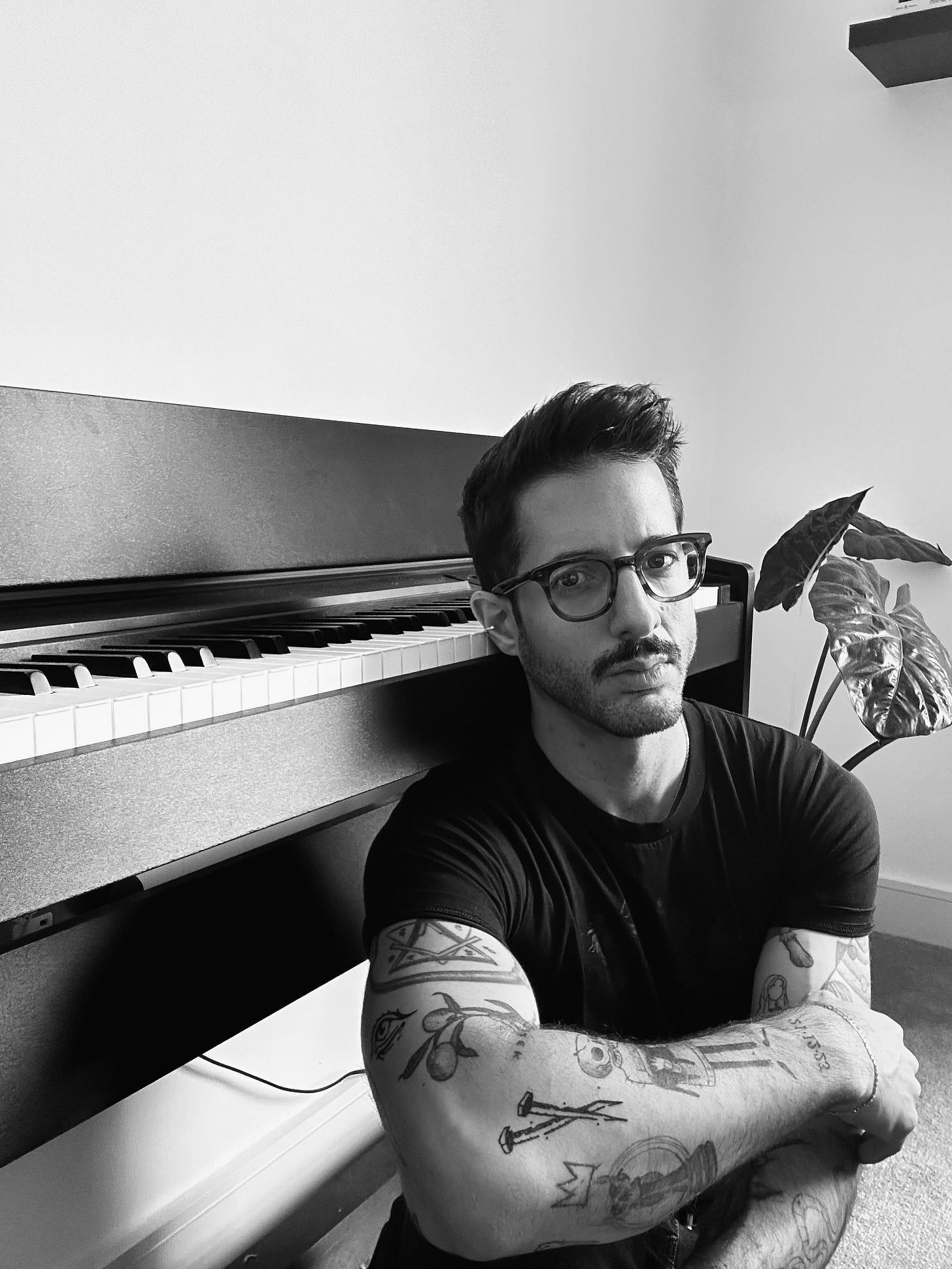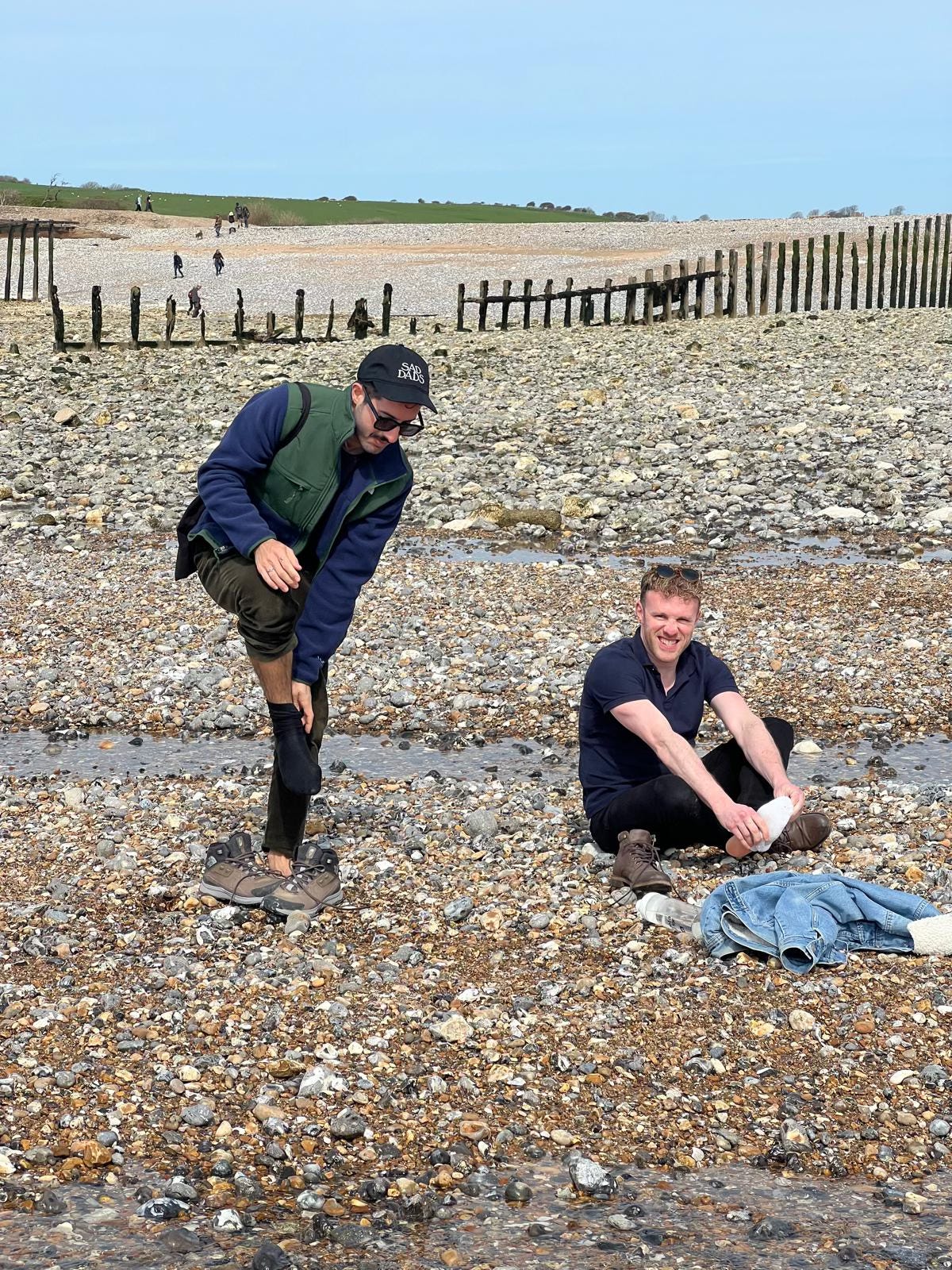Part of the mission of the Seaford Review is to shine more of a spotlight on the people making, submitting, and working with poetry in 2024. Lyric doesn’t come out of nowhere, and too often the way we publish these days — particularly in smaller or ‘indie’ presses — cuts poetry off from the context which nourished and gave rise to it. We’d like to shift some of the focus back onto our poets, and the language-worlds in which they are working.
One of the ways we’ll do this is by offering our published poets the opportunity to do a Q&A, which will follow in the wake of the issue that features that poet’s work. As a way to kickstart this process, we thought we’d run an initial Q&A with our editors, this time with Luís. The idea is to help our readers get acquainted with the editorial team before submissions open in September, as well as with the rough format that the Q&A will take.
Luís was born in Lisbon, has lived in London for the past twelve years, and now calls Warsaw his home. He is the author of the pamphlet two dying lovers holding a cat (fourteen publishing, 2024), and his poems have been published in several literary magazines and journals. For a taste of his writing, you can find his poem Rite in Issue 3 of The Marbled Sigh.
Christopher Lloyd: Hi Luís, welcome!
Luís Costa: Hello Chris!
CL: I suppose I will start with the same question you asked Jack. Can you tell me a little about your writing practice? Where and when do you write?
LC: I am a ritualistic person, so I have a few places where I like to write, depending on the stage of the process. When there is an idea for a poem and I have gathered enough of it - and this varies a lot: sometimes it’s only a word, other times full verses - I like writing in my local pub.
CL: Okay, pause. I have to ask what you drink now.
LC: In the warmer months, a glass of Sauvignon Blanc. Sorry, Chris, I know you dislike this wine! Most of the year, a glass of Malbec is my go to. I always pick the same table though.
Both laugh
LC: In contrast with my organised, more routine-oriented nature, I prefer a more chaotic space to write. So I have written most of my poems in bars and coffee shops, particularly when travelling.
After putting the words to a page, I tend to edit the poems at home in a quieter environment, often at my dining table. Great things always happen at dining tables. That being said, most of my writing process happens when I am actually not writing.
I like to go on long walks or runs with music, that is usually when the ideas come about. I end up sending a lot of messages to myself with thoughts, lines, or out of breath voice recordings if I’m jogging, which I later transform into poems.
CL: It seems like your writing process has an ongoing element to it?
LC: Most definitely. A lot of writers will relate to this, I suppose. But my writing also serves, ironically, as a way to crystallise a moment, an experience, or a feeling. And this ties in with the travelling aspect I mentioned earlier. There is so much happening when you travel. New languages, new views, new people. My poetry is so influenced by this… and then tries to make emotional sense of it too.
CL: I would say there are often aspects associated with different cultures, whether through imagery or language, which surround the action or emotional space of your poems.
LC: Yes, I imagine I will always have this element in my writing. After all, I’m a migrant, I’m constantly surrounded by cultural elements that I borrow. The most evident one being that I write in a foreign language. This is such a beautiful thing, it adds a unique layer to my work.
CL: Is this something you have thought about exploring more?
LC: It is surely something I will address further, especially when it comes to my cultural identity, which is made of so many parts now. Time will tell where it goes, but at the moment I will continue to bring this into my poetry, even if in more subtle ways.
CL: And what other topics would you say tend to inspire you?
LC: Anyone who has read my poems will probably say heartbreak. Or death.
Both laugh
LC: And while I have written a fair bit about those topics, I prefer to think that rather than topics, a key element of my poetry is its particularly visual nature. It uses a lot of vivid imagery to convey feelings (yes, sometimes heartbreak and grief and sadness). And this is because I feel very connected and inspired by visual art. It tends to move me greatly, probably only second to music. For example, after visiting a museum or a gallery, I write a lot.
I’ve always been a creative person and very much in touch with the arts throughout my life, particularly music as I started to learn how to play the piano at a very young age. But some visual art has this overwhelming power to uncover emotions in me, which I then explore in my poetry - often in a nonlinear way.
CL: This makes a lot of sense.
LC: And one thing I used to often was ekphrastic poetry, mostly for the now sadly extinct Visual Verse poetry magazine; I adore using visual art as a prompt, probably because I project feelings onto images more than anything. So in a way, a painting or a photograph can serve as a mediator for my poetry.
CL: I will put you on the spot now. Is there any particular artwork that comes to mind?
LC: laughs
Sure. I was just in Vienna and saw the Waterlily Pond by Monet, which inspired a poem shortly after. I hate typing on my phone, but I had no other way as I was out and about, so the poem was born on a note. This is an example of a painting which evoked such strong feelings in me, I needed to put them down straight away. Almost as if I decoded or deciphered them in the poem. Poetry is a way of decoding experiences.
CL: I love that.
LC: Yes. Funny enough, parallel to psychology, my background is incredibly analytical. I spend a lot of time looking at numbers and statistical analysis. Poetry, in a way, serves as equations for my emotional world. Even if sometimes there are no solutions.
Both laugh.
CL: I think we can all relate to that. Can you tell me about one of your recent poems?
They discuss Luís’ poem Rite
CL: This is also an example of a poem that references and is inspired by a piece of art: Stravinsky’s Rite of Spring. And one that also uses powerful imagery.
LC: Exactly. This poem is part of a group of poems I have written earlier this year exploring death and grief. Specifically, the experience of being surrounded by it, when you are trying to move within the fog.
The idea for this poem actually came to me in Seaford, so it is only right I chose this one for us to discuss today. I remember turning on a radio in the kitchen, listening to an orchestral piece and realising how effortlessly it invaded the room. It didn’t matter what I was thinking or feeling. It just was. So in the poem I describe this scenario in which daily things are still very much occurring whilst I am paralysed by the pain of loss.
CL: The pasta boiling, the clothes drying.
LC: Yes. And how it is all part of this rite we perform when we grieve.
CL: There is also an element of hope in this poem…
LC: There is - I used the spring imagery, directly from Stravinsky, tying it all together. At the end of the rite we need to perform to process the insurmountable weight of loss, there is light. The clocks change at the end of winter, nights get shorter.
CL: You know what I will ask you now. Tell me about a poem you wish you had written.
LC: Of course! I will always give the same answer to this question, because it’s my favourite poem. And it is also related to the one we just discussed. It’s called Kot w pustym mieszkaniu/Cat in an empty apartment, by Wisława Szymborska. It is a gorgeous poem that explores grief through the perspective of a cat. That first verse “Dying – you wouldn’t do that to a cat.” is so powerful.
There are so many things to love about this poem: the absence described through heartbreaking yet quotidian imagery, the humour, the way it so lightly taps into darkness. It’s beautifully crafted and I love the storytelling element of it, which is something I am trying to explore more in my own poetry as of late.
CL: It is a stunning poem. Can you also tell me what is on your bedside table?
LC: I don’t keep a lot of books on the bedside table, as they tend to circulate around the house, so I will not be very literary with my answer. However, I do have a copy of the Polish edition of the Little Prince, which I bought when I started learning the language a couple of years ago. I read it many times as a kid - and I firmly believe everyone should read this book. Particularly if you are a poet. I also have a Nigella Lawson candle and my earphones –
CL: This is extremely you-coded!
Both laugh
LC: Evidently
CL: Lastly, tell me about your aspirations for the Seaford Review?
LC: Poetry is on a comeback tour, which is fantastic. There are so many amazing poets out there, making astonishing and very different and unusual poetry right now. I want the Seaford Review to be the home for these poems, but more importantly for the poets themselves.
As we will aim to give our readers more insight into the poets’ work and experiences, I hope we can provide a platform for these voices, so they can reach wider audiences. I truly want our readers to feel they know the poets a little bit - and I want the poets to feel they were given a stage to showcase their work, their personalities, and how the two are tied together.
Submissions for the first edition of the Seaford Review will open in September. Stay up-to-date by following us on Instagram and X/Twitter.






